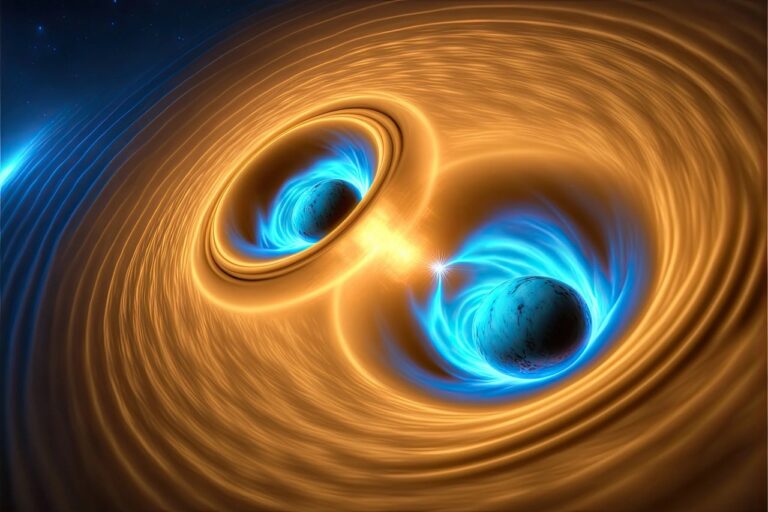The monumental clash between two black holes reveals a groundbreaking detection of fresh gravitational waves.
The incredible event of merging two black holes located 2. At a distance of about 4 billion light-years, this eventually led to the discovery of gravitational waves by the LIGO-Virgo collaboration on the 12th of April, 2019, that is about one and a half years ago. This occurrence, however, is quite normal in the field of research and development nowadays.
However, astronomers have discovered that there was something peculiar about the real GW 190412 merger. GW 190412 originated from a highly asymmetric system, not from two black holes of similar mass lying between 20 and 40 solar masses.
By studying the spreading ripples of gravitational waves, the astronomers have estimated that one of the black holes was about 29. Seven times the mass of the Sun, the other was more than three times lighter, only 8. 4 solar masses.
Notably, this black hole pair is the least massive one discovered so far, indicating that their merger produced a longer signal compared to all the previous black hole fusion, which is rich with information.
When viewed independently, neither of these masses is particularly shocking, Black holes of this size are known to exist, said astronomer Christopher Berry of Northwestern University and the LIGO Collaboration in a blog. “What is unique is the mass ratio. ”
“This observation enables us to verify predictions for gravitational wave signals in a new way, and contributes to the emerging picture of how binary black holes form. ”
The results of the Collaboration were reported at the American Physical Society Virtual April Meeting.
It gives a signal that previous occurrences of gravitational waves were due to black hole binaries with very close mass. When two black holes orbit each other, they always come back to the same positions because both have the same amount of mass.
Therefore, the frequency of the gravitational wave generated is almost twice the orbital frequency of the binary system, that is, the time taken by the black holes to orbit around each other. However, if the mass ratio of the two objects in the system is severely skewed then the orbit becomes eccentric. This results in the occurrence of the second, weaker gravitational wave frequency.
For instance, GW 190412 had two frequencies, just like when you pluck two separate strings on a guitar. These frequencies deviated from the standard chirp that is traditionally associated with a black hole merger.
Notably, these frequencies matched a musical interval referred to as perfect fifth, which is a gap of five notes. Specifically, they resembled the first two notes in the melody of ‘Twinkle, Twinkle, Little Star. ’
Not only were these frequencies interesting, but they also offered a chance to perform another test of general relativity as well. Scientists split the gravitational wave signal in two and then using equations based on general relativity they calculated the missing part of the signal for each half.
The values obtained from these computations matched well with the observed data meaning some of the most accurate data was gotten from this particular test so far.
Moreover, the team was able to get several more measurements based on the nature of the signal produced by the merger. They correctly estimated the spin of the bigger black hole, which is usually very difficult and has been achieved only twice (with some reservations).
Anticipating, it is worth noting that in GW 190412, the spin seems to be relatively high, which may explain the formation of such an asymmetric binary system. Indeed, there are numerous theories describing the formation of black hole binaries, and most of them suggest that the two objects have similar masses.
For instance, a binary star system where each star at the end of its lifetime transforms into a black hole is a good example. Nevertheless, GW 190412 is not likely to result in the formation of a binary black hole with large mass ratios.
One possibility is that the black holes were created individually and later they coalesced and started to revolve around each other by some unknown mechanism. However, due to the high spin value of the larger black hole, it can be inferred that the black hole had merged with other black holes before GW 190412.
Perhaps the observed black hole has already formed part of a triple or quadruple system with other black holes. If it were just hanging around in normal space it would be disrupted. However, there is one scenario in which this could be possible: in the accretion disk around an active supermassive black hole located at the heart of a galaxy.
Presumably, stellar-mass black holes in that region may merge several times before being expelled due to the recoil kick.
Although it’s hard to say for sure right now, we might not have to wait too long to find out because the LIGO-Virgo cooperation is producing detections every few days.
By the way, GW 190412 caused more coincidences than just the dyad. “Approximately equal to the ratio of filling in a regular Oreo to in a Mega Stuf Oreo,” is how Berry described the mass ratio between the two black holes.
“Investigations of connections between Oreos and black hole formation are ongoing.”
The team’s whole article is available on the LIGO website.
Do not forget to share your opinion with us to provide you with the best posts !




0 Comments